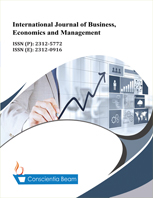Exchange Rate Volatility and Agricultural Commodity Prices i Nigeria (2000-2018)
DOI:
https://doi.org/10.18488/journal.62.2020.75.290.300Abstract
Exchange rate stability is one of the main factors that promote investment, price stability and stable economic growth. However, the effect of positive and negative changes in exchange rate has been a controversial debate among academia and experts. Thus, this study seeks to examine the effect of exchange rate volatility on agricultural commodity prices in Nigeria. Additionally, the study examines whether exchange rate volatility have a symmetric or asymmetric effect on agricultural commodity prices in Nigeria. In order to account for the volatility behaviour such as nonlinearity and time varying risk, the study used the Non-linear Autoregressive Distributed Lag (NARDL) model with monthly data for real effective exchange rate, agricultural output prices, inflation rate, and RGDP between 2000 and 2018. The study found that there is a positive and significant relationship between positive changes in exchange rate and agricultural commodity prices and also between negative changes in exchange rate and agricultural commodity prices. The study found that inflation rate has negative effect on agricultural commodity prices while RGDP has a positive effect on it. Asymmetric test using Wald Statistics revealed that positive and negative changes in exchange rate of the same magnitude have equal impact on agricultural commodity prices. The study concluded that movement of the exchange rate plays a significant role in altering the prices of agricultural commodity in Nigeria and the volatility effect is symmetric on agricultural commodity prices in Nigeria.

